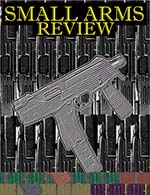Subsonic .308 Ammo from Engel Ballistic Research
By Mark White
We recently received a sample of .308 subsonic match cartridges from Engel Ballistic Research Inc., Rt 2, Box 177C, Smithville, TX 78957; Phone 512-360-5327, Fax 2652.
This sample of ammunition is of special interest to us because it comes at a time when very little subsonic ammunition is available in the U.S., and where accusations of inaccuracy and instability are flying between domestic importers of foreign ammunition, and some suppressor manufacturers, each blaming the other for problems their customers may be experiencing.
I covered accuracy and instability in my three-part SAR article on silenced sniper rifles, but would like to mention a few key points again. In .308, one will have the greatest likelihood for dependability and accuracy if: 1) The suppressor is fastened to its barrel with a two-point mount. 2) If the first (and possibly the second) blast baffles is/are symmetrical and axially aligned with the bore. 3) If inherently stable bullets, with round-noses and flat-bases, are used. 4) If the barrel has an adequate twist rate and rifling style for the bullet length and, 5) If the silencers in question have adequate clearance within the cone of dispersion that the departing bullets will describe.
When EBR’s .308 cartridges came in we pulled two rifles from the rack for testing. The first was a standard Remington 700 Varmint rifle with a 1 in 12-inch twist barrel and a synthetic stock. The second rifle was a Savage Tactical with an aftermarket Choate, Ultimate Sniper stock, a 1 in 10-inch twist barrel and an aftermarket, Sharp Shooter trigger.
Velocity testing took place by loading five cartridges in each rifle in an air-conditioned room held at 70 degrees F. The rifles were taken out individually and fired rapidly over a chronograph in 85-degree ambient temperature. The velocities from the Remington were, in order : 991, 1019, 1023, 1032 and 1054 fps. As the weapon’s bore heats up from prior firing, less and less heat is withdrawn from the propellant gas by conduction to the metal in the barrel, thus we expect succeeding shots to be faster and faster as the barrel heats. We see this to a lesser extent in .22 LR firings. The heavier the caliber, the greater the effect, although it seems more accentuated in subsonic loadings than in full-powered loads because there is less gas to work with. The Savage rifle shot its subsonic rounds at 989, 1014, 1031 1056 and 1089 fps, respectively. We expect a little variation in velocity because it is very difficult to get uniform powder measurement and placement in a case that will easily hold 50 grains of powder. We find these velocities to be very consistent and uniform for the low-density, .308 loading.
EBR calls this ammo 7.62mm Thumper, because it uses a heavy, moly-coated, 220 grain round-nosed, flat-based bullet. Slow-fire accuracy testing was conducted under windless conditions the following morning. We had no trouble keeping three-shot groups inside a half-inch at 100-yares, with either rifle. It should be mentioned, however, that the point of impact was roughly 14-inches below, and a bit to one side of our center if aim, as both rifles were sighted in for high-velocity, 158 grain, match ammunition. The difference in pint of impact is due, in part, to different recoil characteristics between the high and low velocity cartridges, and occurs whenever ammunition with substantially different energy levels are used. Both rifles carried heavy, Sound Tech suppressors, which dampened muzzle rise. The sound level appeared to be less when compared with other subsonic ammunition we have tested.
Lighter weight, unsuppressed rifles will be likely to experience a greater degree of apparent drop than 14-inches. If one will be using this ammunition for serious work we recommend sighting the weapon in to accommodate subsonic trajectory and rotation, at a range at which firing is anticipated. It is very difficult to remember the zero for different rounds. Not impossible, but difficult. We also suggest using Thumper ammunition exclusively, rather than mixing ammo types. Round-nosed bullets with flat bases are dependably stable, inherently accurate, and usually penetrate in a straight line. Do not expect subsonic ammunition to be noiseless in an unsuppressed weapon. The report will be substantial unless a suppressor is involved.
The 220 grain, moly-coated bullet should deliver about 484 foot pounds of energy at 1000 fps. While the suppressed report was mild, we noticed both rifles recoiling about three inches, judging by the skid marks generated by the bipod on the shooting bench. It is apparent that 220 grains of lead and copper are traveling down range each time the trigger is pulled.
We pulled a bullet from one of the cartridges and got about 12.7 grains of a coarse, light, tubular powder, of a type that we are unfamiliar with. In all of the EBR testing we conducted, none of the subsonic bullets broke the sound barrier. This is significant, as other samples of subsonic rounds furnished us by other manufacturers frequently broke the sound barrier. This is supposed to be stealthy stuff, and it won’t be stealthy if it goes beyond the speed of sound.
Engel Ballistic Research is currently at work on a heavy, .30 caliber rifle round that purportedly will expand reliably and effectively at velocities below 1000 fps. To date, we have not seen a rifle bullet capable of doing this, and we look forward to testing this round in the future.
This article first appeared in Small Arms Review V2N1 (October 1998) |
| SUBSCRIBER COMMENT AREA |
Comments have not been generated for this article.




